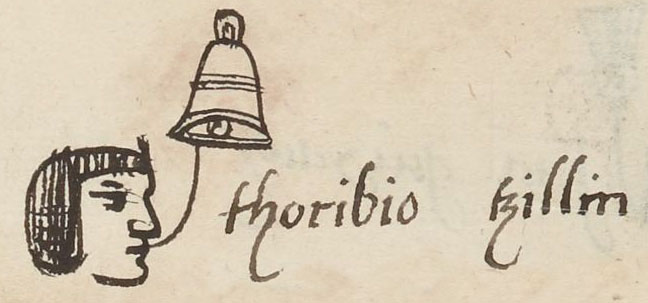Tzilin (MH486r)
This black line drawing of the simplex glyph for the verb to ring bells (tzilini) is shared with the personal name, Tzilin (perhaps "The Bell Rang"). The glyph comprises a frontal view of a bell. The bell has a flare at the bottom, a loop at the top for hanging it, and it has horizontal lines around the middle for decoration. The clapper is visible inside the bell.
Stephanie Wood
Perhaps tzilin is meant as a noun here. This glyph does not visually capture the sound of a bell ringing, which would be really interesting. The autonomous-era type of bell (coyolli) as shown on folio 44 recto of the Codex Mendoza (see below) has little sound scrolls coming out of the bottom. The coyolli (jingle bells) were usually small copper or gold bells, but this one for the verbs tzilini or tzilinia looks more like a church bell, showing Spanish influence. It has a wide mouth and a protruding clapper. The loop at the top does coincide with the loop of some of the coyolli bells, which could hang from a skirt, from jewelry, or from a leather thong around ankles, for instance, when danced. Juan José Batalla Rosado (2018, 96) includes the various glyphs related to the verbs tzilini and tzizlinia in his study of visual loans, given that the iconography of these bells has been greatly influenced by exposure to European bells. He also points to the new occupation of bell ringer and its seeming neologisms tlatzilini or tlatziliniani (2018, 97).
This is a personal name, preceded in the gloss by a Christian first name (Toribio). He may have been named after Toribio de Benavente, also known as Motolinia ("One Who is Poor or Afflicted"). This was the first word Motolinia learned in Nahuatl, and he went on to learn the language well. He lived in the monastery in Huejotzingo. Doing a quick search for the name "Toribio" will produce an impressive result.
Stephanie Wood
thoribio tzillin
Toribio Tzilin
Stephanie Wood
1560
campanas, metales, nombres de hombres

tzilini, for a bell to ring or chime, https://nahuatl.wired-humanities.org/content/tzilini
coyol(li), jingle bell, https://nahuatl.wired-humanities.org/content/coyolli
el cascabel, la campana
Matrícula de Huexotzinco, folio 483r, World Digital Library. https://www.loc.gov/resource/gdcwdl.wdl_15282/?sp=51&st=image
This manuscript is hosted by the Library of Congress and the World Digital Library; used here with the Creative Commons, “Attribution-NonCommercial-ShareAlike 3.0 License” (CC-BY-NC-SAq 3.0).








